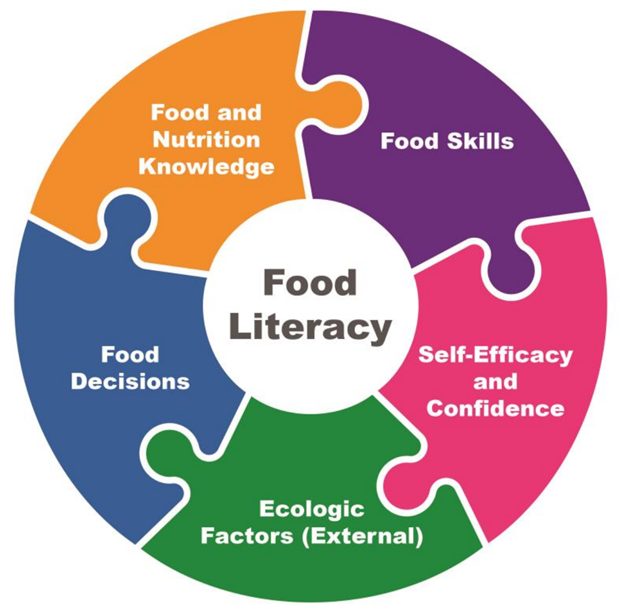Highlights
- Increasing food literacy in youth can improve eating habits and reduce the burden of nutrition-related chronic diseases in Ontario.
- School-based food literacy programs are key to increasing healthy eating in youth.
- More work is needed to help ensure equitable access to healthy food and to help people maintain an interest in health literacy throughout their lifespan.
School-based food and nutrition programs that teach food literacy are important in developing a foundation for healthy food behaviours across the lifespan. Food literacy encompasses having knowledge of various foods and nutrition to make healthy food choices, the confidence to purchase and prepare food (i.e., food skills), as well as socio-ecological factors such as the availability of healthy food options, the climate and conditions that food is grown in, and the social determinants of health (see Figure).[1][2][3]
Figure: Food Literacy Framework

Source: Locally Driven Collaborative Project “Measuring Food Literacy in Public Health”, 2016
Note: The Locally Driven Collaborative Project (LDCP) Healthy Eating Team would like to thank Public Health Ontario (PHO) for its support of this project. The Team gratefully acknowledges funding received from PHO through the LDCP program. The views expressed in this project update are those of the LDCP Healthy Eating Team and do not necessarily reflect those of PHO.
Evidence suggests that better food literacy can also reduce consumption of ultra-processed foods (foods high in saturated fat, sodium and sugars), which are often relied upon due to ease of access and time constraints.[4] Research has established a strong association between consuming ultra-processed foods and developing cancer, hypertension, diabetes and a high body weight.[5][6] Canada ranked fourth highest among 80 countries in consumption of ultra-processed foods,[7] and data from the 2015 Canadian Community Health Survey found that youth under age 18 are among the highest consumers of these foods.[8] Eating a nutrient-rich diet can help prevent the onset of risk factors for developing chronic diseases later in life.[1][2]
Ontario Health’s 2020 Prevention System Quality Index (PSQI) reported that only 30% of students in Grade 9 take courses with a food literacy component.[2] Literature supports that learning hands-on skills (including cooking, taste-testing and gardening) helps to improve healthy eating outcomes in children.[9] A 2022 study of youth ages 9 to 14 in Southwestern Ontario found that higher food literacy was associated with a higher intake of fruits and vegetables.[10] To address this need, Bill 216 – The Food Literacy for Students Act was introduced in October 2020 to include experiential food literacy and healthy eating as part of the school curriculum for students in Grades 1 to 12 in Ontario.[11] The growing momentum to advance food literacy has led to the Ministry of Education updating the fall 2022 curriculum to include information on agriculture, climate change and biodiversity within our food systems in Grades 1 to 8.[12] However, further advocacy is needed to continue the momentum on improving food literacy in adolescents in the province.
More work is also needed to increase the affordability, availability, and access to healthy food.[2] For example, certain populations that face systemic discrimination, such as Indigenous Peoples, racialized persons, and people who have moved from other countries, can experience food insecurity that minimizes access to healthy food options.[13][14] As a result of this and other systemic inequities, these populations tend to carry the highest burden of chronic diseases in the province.[15][16][17][18] Improving food literacy amongst youth with intersectional identities will require additional measures that focus on the social determinants of health and food insecurity.[19][20] Equity-based approaches to improving food literacy must ensure sustainable food environments that provide access to healthy foods for all people living in Ontario.[13][14] To learn more about health inequity related to cancer prevention in the province, see the 2018 PSQI: Health Equity report.
If you have comments or questions, please send us an email.
